Liverpool plays with 4-3-3 line up. When they lose the ball in set attack, they use gegenpressing to take the ball back. We can explain gegenpressing basically that when the attacking team loses the ball, they try to take the ball back as quickly as they can. So the opponent has to think extra fast to make a productive counter attack opportunity.
But naturally Liverpool (and another team which one wants to use gegenpressing) doesn’t use gegenpressing if they don’t have enough players to use gegenpressing. I mean for example, in this situation, let’s say Liverpool’s right stopper tries to pass to the center forward. But the opponent’s defensive midfielder cuts the connection between centre forward and right stopper. When the opponent’s defensive midfielder takes the ball, Liverpool don’t have enough players to use gegenpressing. Wingers and centre forward can’t close to the opponent’s defensive midfielder quickly because they are too far away from him. Midfielders are not close enough to the ball like the opponent’s midfielders and centre forward. So because they don’t have enough numerical intensity, they can’t use gegenpressing.
Because if they want to use gegenpressing, because they are not close enough to the ball, they can’t close to the ball quickly and this time, the opponent has enough time to think and play. And also gegenpressing’s meaning is, to take the ball back quickly in forward, moving forward as a team. So if you can’t use gegenpressing effectively, the opponent can make a counter attack more easily because the defense has more space for the opponent. Because all the team moved forward. So if you don’t have enough intensity but you try to use gegenpressing, it just helps the opponent to make a counter attack comfortably.
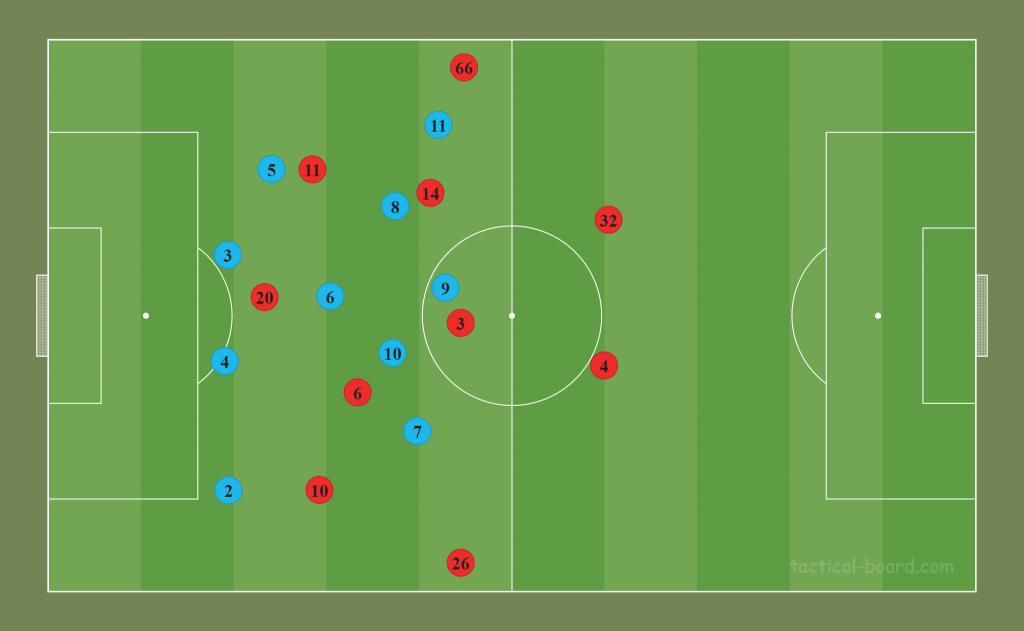
If we go back to our situation, if Liverpool’s players would take position like that, they could use gegenpressing effectively. Because this time, when the opponent’s defensive midfielder cuts the connection and takes the ball, Liverpool’s midfielders can close to the opponent’s defensive midfielder quickly. Because they are closer to the ball than the opponent’s players. So they have enough intensity. And because the opponent’s defensive midfielder can’t play quickly, forwards and defenders have enough time to close the gegenpressing area. So all the team supports the gegenpressing.
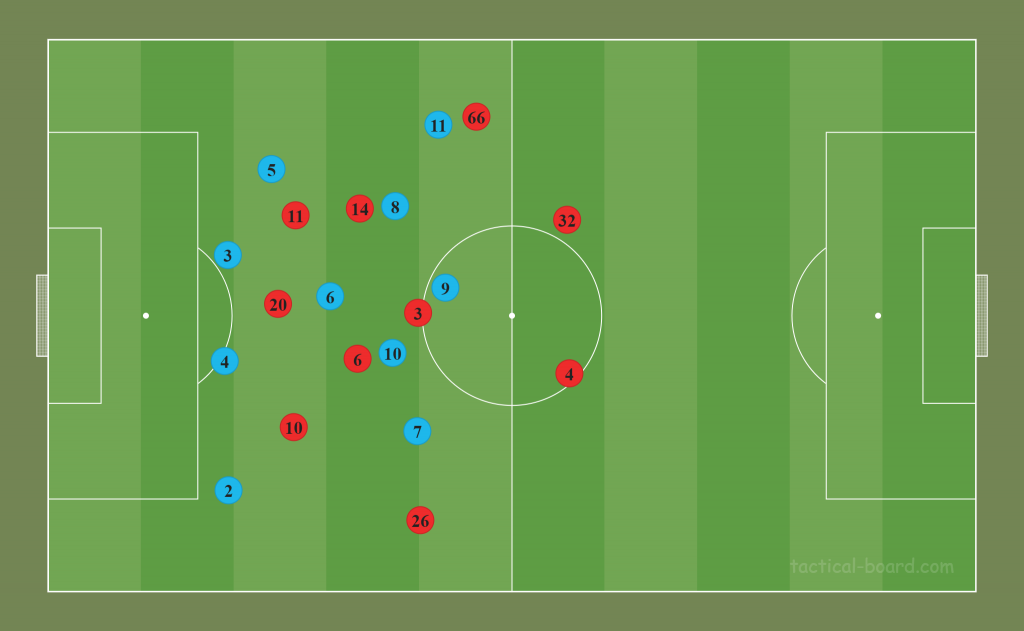
In gegenpressing, basically, the players who are able to react quickly to take the ball back, close to the ball. As I explained, all the team supports gegenpressing but the defensive midfielder and defenders have to think extra about defense line’s and the opponent’s forward players’ situations. If before the midfield line the offside rule would be still valid for the opponent, all the defensive midfielders and defenders could support gegenpressing without thinking about the opponent’s forward players’ positions. But because before the midfield line there is no offside, they have to be extra careful.
The defensive midfielder’s role is taking position in centre midfielders’ and forwards’ behind and when these players focus on to the space where the ball is too, if the opponent tries to make game directly and pass the gegenpressing, cuts the direct pass and wins the ball for Liverpool.
In gegenpressing, the defense line takes position in midfield’s front. Of course Liverpool’s both full backs support attacks. But because the defense line takes position in midfield’s front, full backs can catch defense line quickly because the distance between them and defense line becomes less. Also because Liverpool use gegenpressing, the full back who is closer to the ball supports gegenpressing and doesn’t care the opponent’s winger who matches with him. Even the winger goes forward, the full back supports the gegenpressing and closes to the gegenpressing area. But it’s not a problem for Liverpool because the stopper who is closer to the full back closes to the winger and covers him. It’s an important thing. The stoppers have freedom to go forward and push the gegenpressing. If a stopper closes to the opponent’s winger, the other stopper takes position centrally. The full back who takes position in the opposite wing goes back to the defense line. And they can make these moves quickly because the defense line takes position in midfield’s front. So the defense line can support the gegenpressing productively.
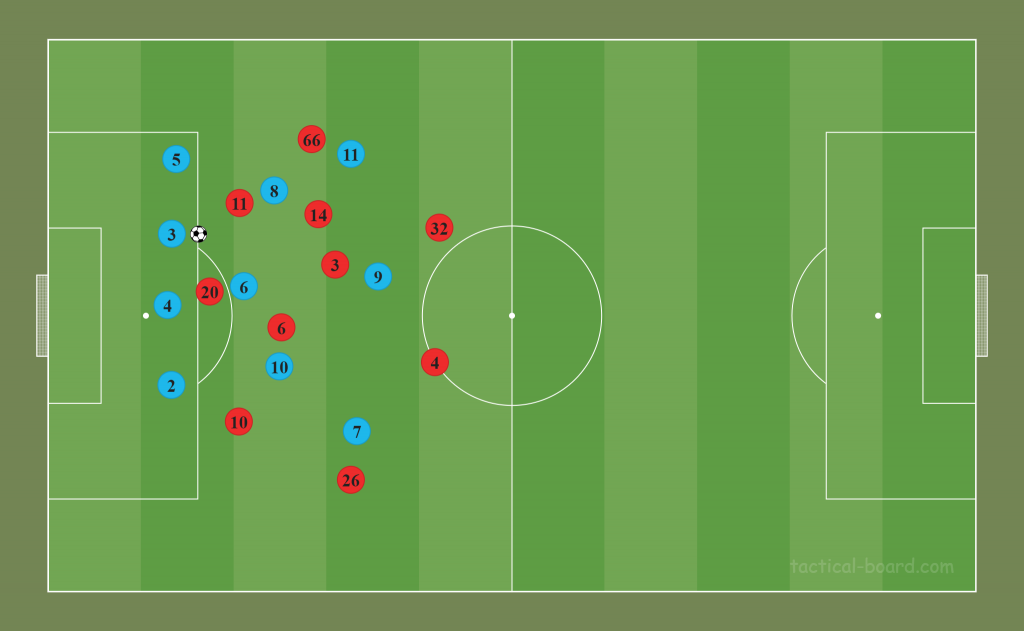
If the defensive midfielder can’t take position well and the opponent can pass the gegenpressing with a direct pass and if the opponent’s player who takes the ball, takes the ball in between defense line and the defensive midfielder, the gegenpressing fails and the defensive transition starts. So the defense line and all the team starts to go back. But also the opponent’s player who takes the ball has to take position closer to the defensive midfielder’s area, not the defense line’s area.
It can be confusing to understand. To explain better, if the opponent’s player takes position closer to the defense line, as I explained before, one of the stoppers can match him quickly after the player takes the ball and doesn’t let the opponent’s player use the ball productively. So the gegenpressing works. If the opponent’s player takes position closer to the defensive midfielder and the defensive midfielder can see him, the defensive midfielder can close to the opponent’s player’s front and take the ball before him. So the gegenpressing works again.
But if the opponent’s player takes position closer to the defensive midfielder and the defensive midfielder can’t see him, the opponent’s player can take the ball free and not Liverpool’s any player can press to him quickly. So the gegenpressing fails. The gegenpressing fails because first of all, when the opponent’s player took position closer to the defensive midfielder instead of defense line, he escaped from the defense line’s marking threat automatically. Because now covering him is the defensive midfielder’s mission. Because now he is in the defensive midfielder’s covering area. But if the opponent’s player takes position out of the defensive midfielder’s visual angle, the defensive midfielder can’t see him and because the defensive midfielder can’t see him, he can’t know where he is and because he doesn’t know where the opponent’s player is, he can’t cut the connection. So the opponent’s player can take the ball comfortably and starts the counter attack. Now let’s look at this situation in a match.

In this position, Liverpool took the ball in right wing with high pressing against Manchester City and started transition attack. Henderson crossed from right wing and Manchester City’s defense line cleared the ball. So Liverpool try to take the second ball.
As you see, left centre midfielder Curtis Jones, right back Milner and defensive midfielder Fabinho closes to the ball. Fabinho also matches with in false 9 role Grealish.
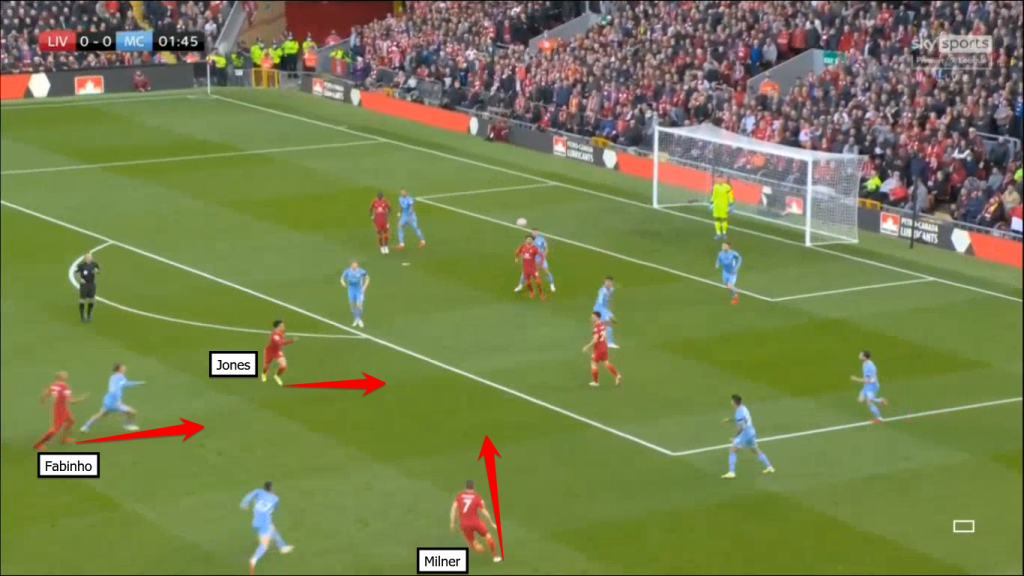
Then Grealish takes the ball before Liverpool’s players and Liverpool try to take the ball back with gegenpressing. And Manchester City try to start a counter attack. In this position, as you see, De Bruyne is completely free. Fabinho followed Grealish and still he focus on to Grealish.
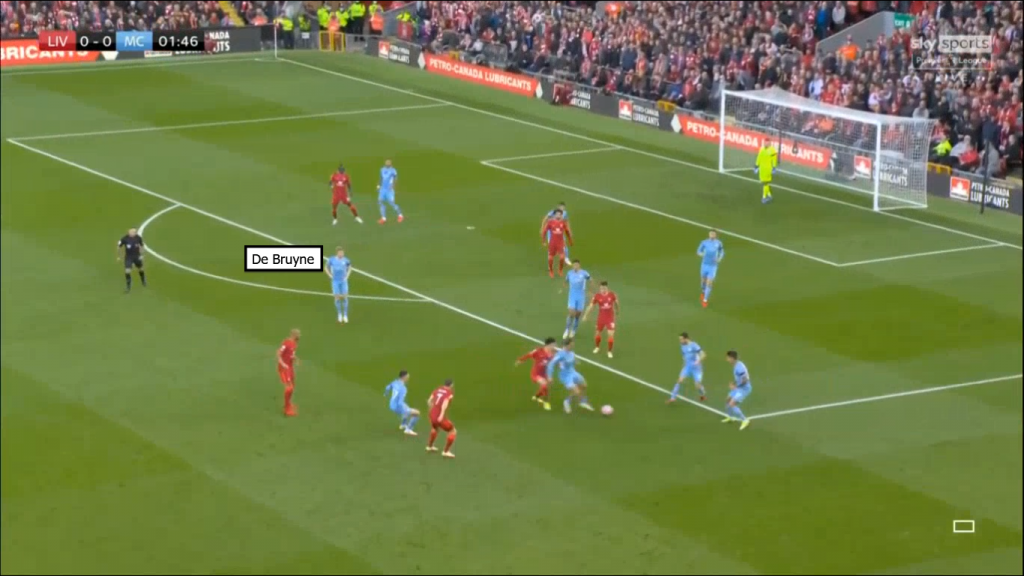
Then Grealish passes to Laporte and when Laporte has the ball, De Bruyne is still free. Fabinho shifted to left a little bit but it’s not enough to cut the connection. And also now De Bruyne remains out of Fabinho’s visual angle and because he was in Fabinho’s marking area, Liverpool’s defense line can’t press to him quickly. So De Bruyne takes the ball and starts the transition attack. Liverpool’s gegenpressing fails.
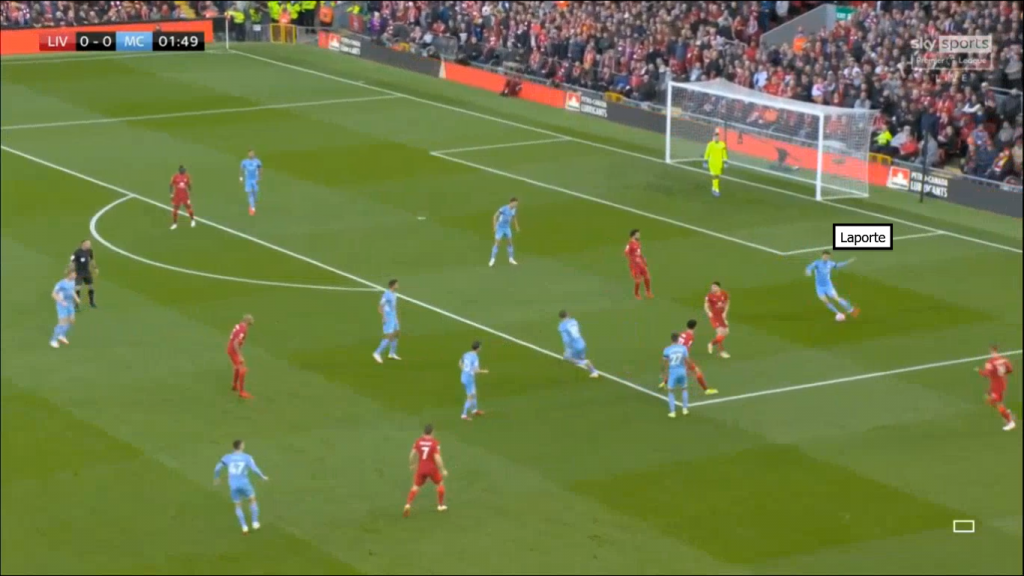
If Liverpool’s gegenpressing fails, transition to defense starts and the defense line starts to go back to midfield line’s behind. But there is an important point. After the defense line goes to midfield line’s behind, defense line stops as a line and meets the opponent. So this time, the opponent’s attackers whose run forward could remain in offside and the opponent’s player who carries the ball can’t pass to the forward players comfortably. And if he closes to the defense line too much, defense line’s one player goes to him and presses to him. Also Liverpool’s players who were in gegenpressing find time to run back. Now let’s look at a match position.
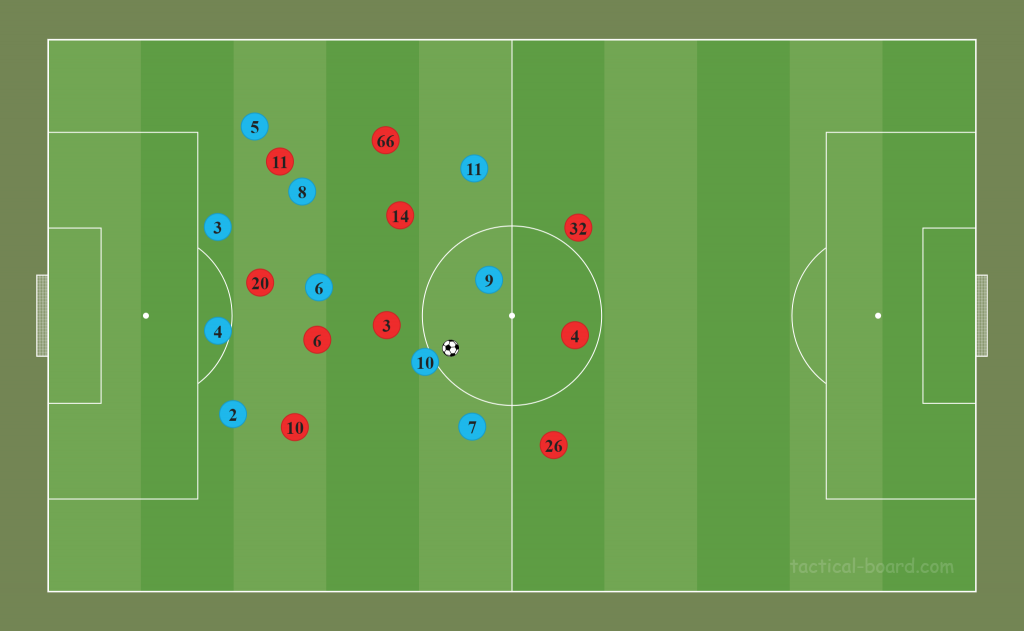
This position is the previous situation’s continuation. De Bruyne took the ball from Laporte, Manchester City started a transition attack and Liverpool try to go back.
As you see, Fabinho tries to catch De Bruyne. Right stopper Matip matches with Manchester City’s left winger Foden because when Milner supported the gegenpressing, naturally, he didn’t focus covering Foden and Matip covered his back. Left stopper Van Dijk takes position centrally and left back Robertson takes position closer to him. All the defense line goes back.
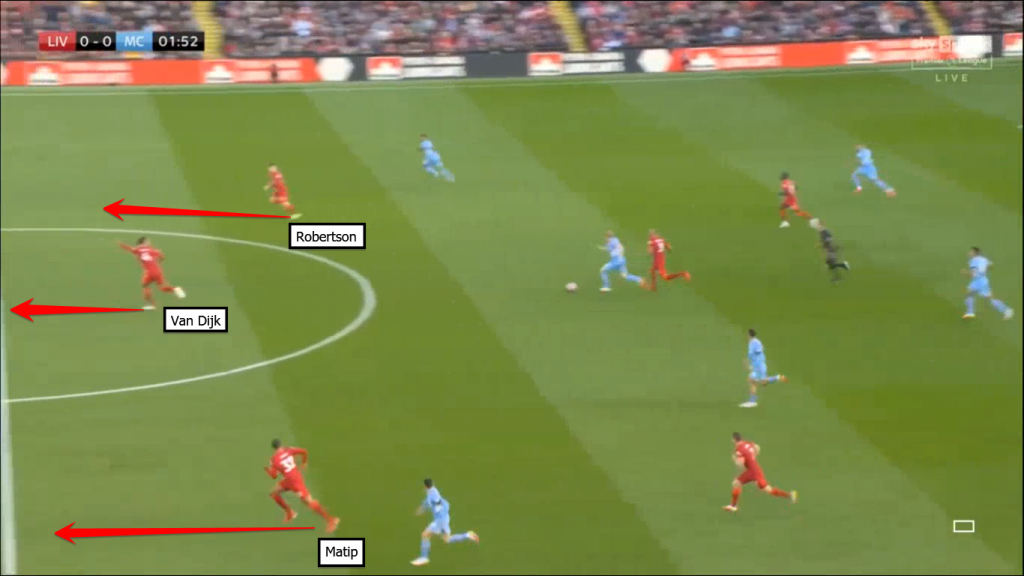
After they go to midfield line’s back, the defense line remains as a line. Matip takes position closer to centre now. And as you see, Foden had to stop his run. Because if he kept running, he would remain at offside. De Bruyne couldn’t pass to Foden because Fabinho disturbed De Bruyne even though he couldn’t catch. And also Matip covered Foden very well.
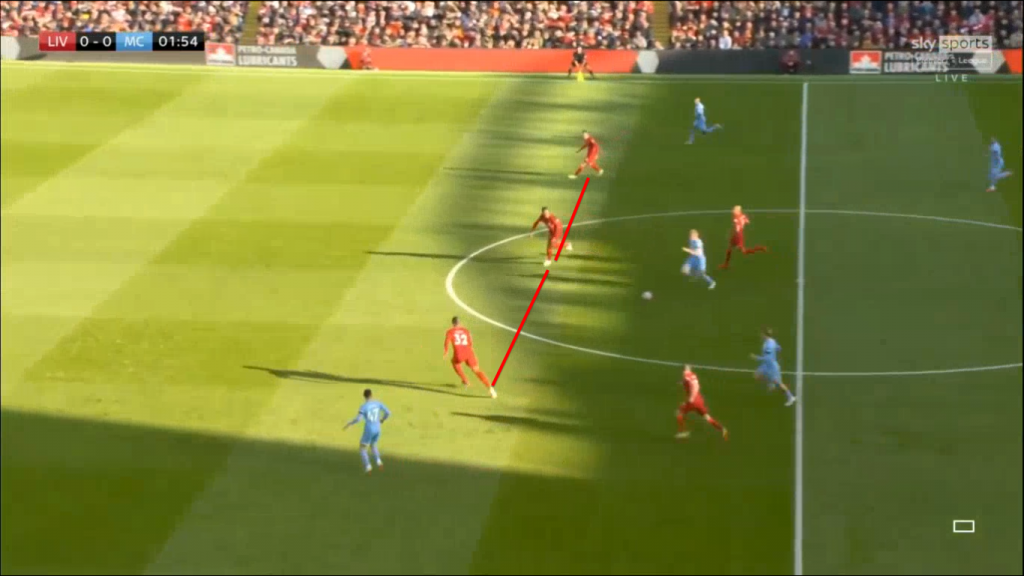
Then Matip closes to De Bruyne to take the ball and De Bruyne passes to Foden. But Foden has to start his run again because of offside. And also, from his behind, because Milner didn’t stop running back, Milner catches Foden. Foden takes the ball but Milner catches him. Foden tries to pass the ball into the penalty box but Van Dijk clears the ball and the referee calls offside. So Liverpool stopped Manchester City’s transition attack.


